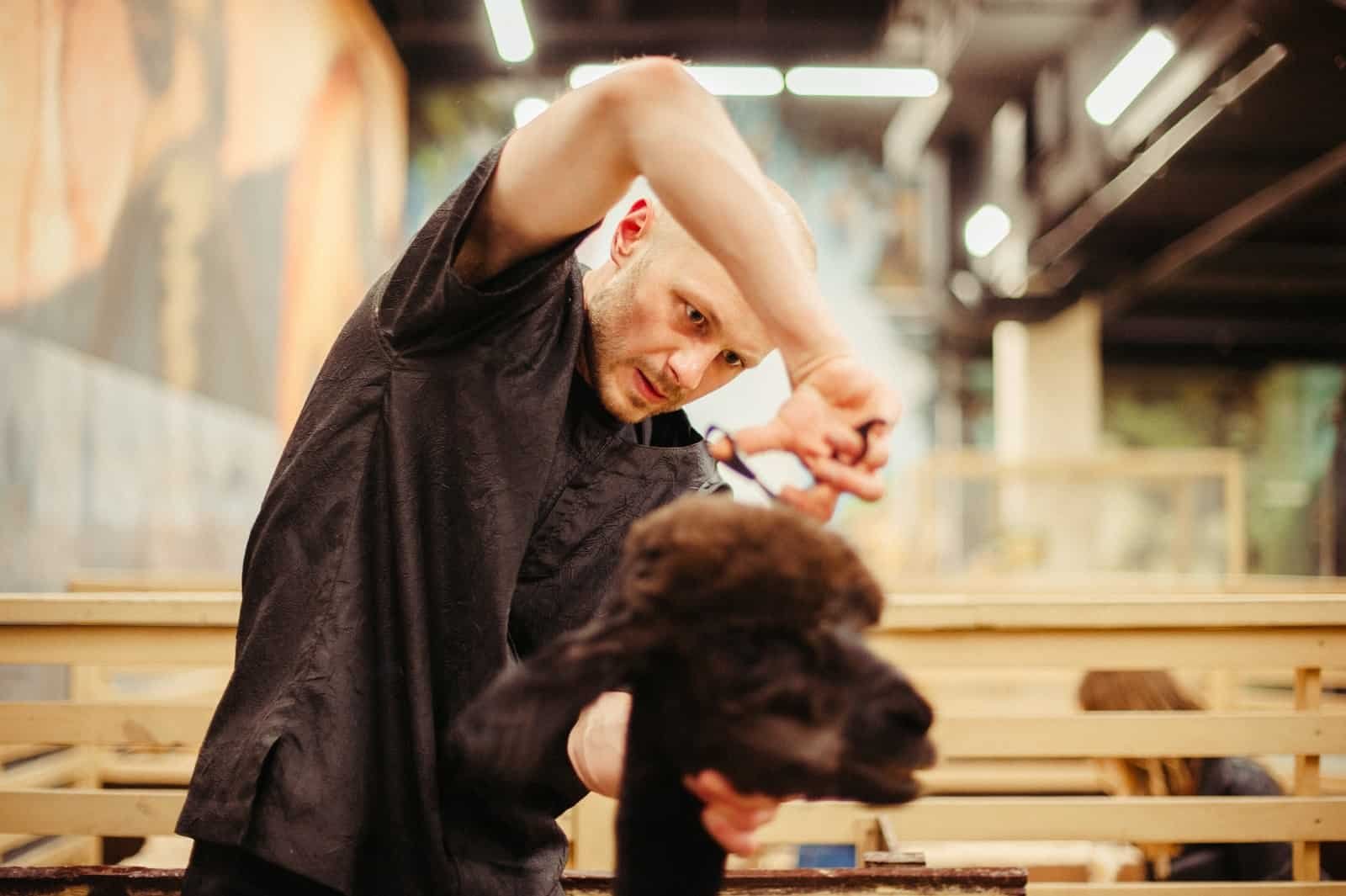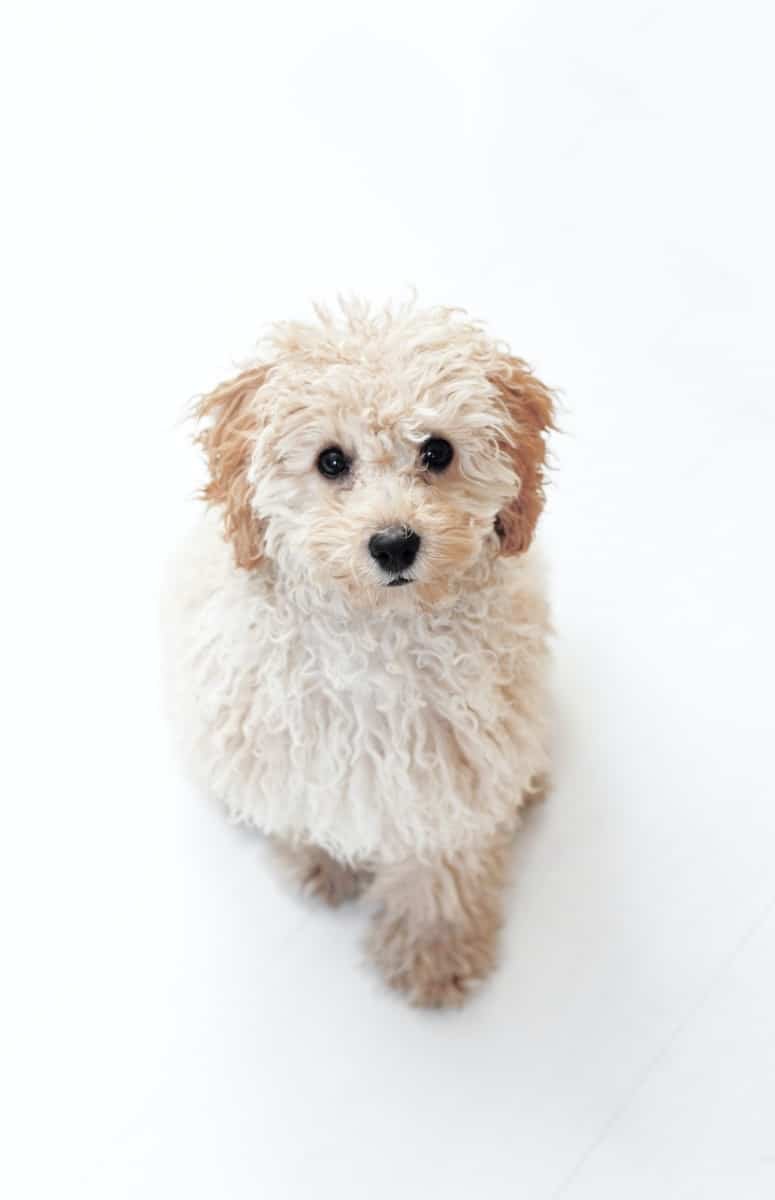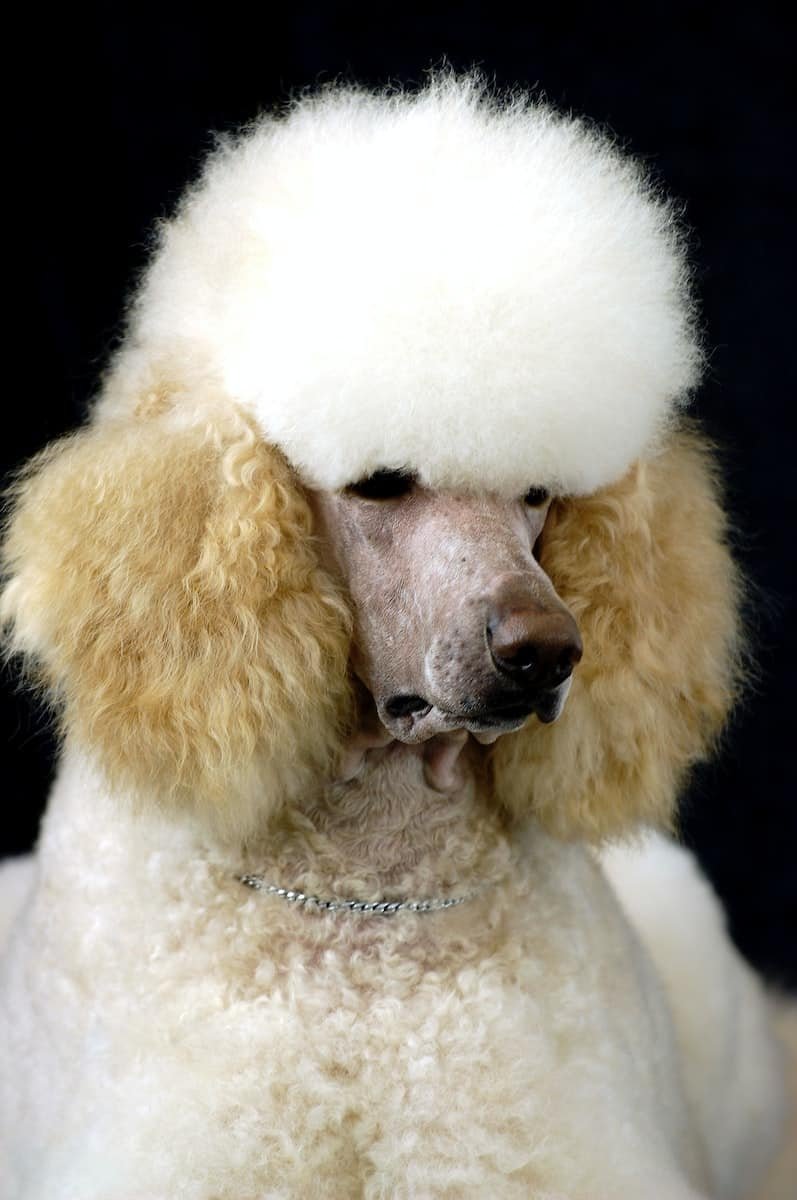
Ever wondered about the fancy Poodle clip you see in movies and television shows, the one with the cute pompom tail and legs with a crescent shape head? That’s the English Saddle clip, which was extremely popular during the 1950s to 1960s. The original beloved poodle haircut paved the way for clever groomers to create more hairstyles.
Let’s deliver deeper into this unique coat fashion.
What is the Poodle English Saddle Clip?
The English Saddle clip comprises a shaved face, feet, front legs, and tail base. The Poodle’s lower forelegs have styled and shaped puffs, while the tip of the tail dons a lovely pompom. Groomers style the hindquarters with a short hair covering, except for a shaved area on the bands and flanks of hind legs. Shave the feet entirely while the remaining parts of the body are in full coat, shaped to look more balanced. Top knots are left long, pulled back into a ponytail.
We don’t see the Poodle English Saddle Clip as much as before because the clip became more varied from groomers who gave their take on the style.
Some groomers believe the clip doesn’t look great on most dogs, most likely since it’s tougher to set lines and have them look flattering on dogs. The more hair a Poodle has, the more difficult it is to develop its lines.
Other Poodle groomers think it would take an excellent dog to pull off the English Saddle Clip since judges aren’t used to seeing it today. Others say that there are structural shortcomings, with the trim making dogs look larger.
As you can see, there are so many opinions on this style, so it has one question whether it’s worth executing the English Saddle Clip.
It’s worth trying if you have a Poodle joining a show event, though it’s best to ask your groomer for advice on this. Your dog may have a particular body shape that makes the clip look off, or you might feel put off with all the maintenance you have to do after the trim!
Groomers agree with the English Saddle clip because it doesn’t match dogs with a soft coat. It’s also more suitable with diminutive or fine-boned Poodles.
How to Do the Poodle English Saddle Clip?
The English Saddle Clip is one of the most challenging AKC acceptable Poodle haircuts to execute. This AKC Poodle clip requires superior clipping and scissoring skills, taking more time than other trims.
After all, you need to scissor and maintain seven pompoms throughout the Poodle’s body, which is very time-consuming. Besides achieving the perfect pompom, you need to brush and comb daily and take extreme care.
While the basic pattern is similar across many Poodles, placing lines and finishing touches will depend on the proportions of every individual poodle. It is easy to commit mistakes if you’re not familiar with working on a long show body coat/ If you encounter an error during the grooming process, it will take months to correct, waiting for the body hair to grow back.
Because of that, the average dog owner can’t perform the English Saddle Clip. We highly recommend pet owners to take their Poodle to a professional groomer for this hairstyle, so you can get the perfect professional finish you expect.
But if you’re confident and have professional grooming experience, then it’s possible to execute the haircut yourself. We suggest bringing your Poodle to a groomer first so that he can trim your dog into the English Saddle clip. Doing so will have him establish lines appropriate for your dog, so you can begin trimming yourself.
If you have a dark-colored Poodle, trim the clipped areas using a #40 blade 3-4 days before any show event. For light-colored Poodles or pet owners who can’t perform a close clip using a #40 blade, use a #15 or #30 blade. Perform the clipping one day before the show event. When clipping your dog, swab his skin using canine anti-itch lotion to prevent irritation post-clipping.
Follow these steps to achieve the English Saddle clip:
- Bathe and blow-dry your dog’s hair straight.
- Clip from the end of your dog’s feet and not above his ankles. We recommend lowering the clipped line rather than risk clipping too much if you’re not a professional groomer.
- Clip your dog’s face and make sure that the clipped lines are straight between your dog’s outer corner of his eyes to his ears. Doing so will set the topknot line.
- Clip your dog’s tail, then shape his pompom at the end. Leave as much hair as you can so you can shape it better. Clip around 1/4 of the tail, leaving hair on the remaining 3/4 to create a pompom. Let your dog stand with his hindquarters facing you, then hold the end of his tail using your free hand.
- Begin clipping the tail hair from the upper side, placing your clippers flat against your dog’s skin. Clip an inverted V forward of the tail base and into the body, so the dog appears shorter from the back. However, don’t go too far, clipping too much. Only clip the sides of your dog’s tail into the juncture to his body. Remember, the underside of your dog’s tail is very sensitive and needs to be clipped from an opposite direction, from his body out to pompom.
- Hold the top of your dog’s tail using your free hand, fluffing the hair out using a comb. Afterward, use curved shears to shape the tail’s pompom, giving it a rounded finish.
- Have your poodle sit facing you so you can clip his throat. You need to trim it into a V-shape, starting from the middle of your dog’s throat, below Adam’s apple. Clip both sides of your dog’s neck up to the front of his ears. Note that you’re working in a sensitive area, so create the v-shape in the opposite direction, beginning from the ear to the throat. That may be more comfortable for your dog. Depending on your Poodle’s neck, you can adjust the V-shape upward or downward.
- Now, let your poodle stand on the grooming table. Using a knitting needle or rat-tail comb, make a part around your dog from the back of your dog’s last rib. The mane, or the hair in front of your dog’s part, should stay long to have a rounded finish later. The saddle, or the hair in the back of the dog’s part, should be scissored for a short and plush finish.
- It’s a bit tough to tell what part of the dog’s body to part his hair, as it varies depending on the dog’s body shape. You can try making the part between 1/2 to 2 inches in the back of your dog’s last rib, depending on the Poodle’s size. As long as your Poodle appears balanced, then you can proceed with the next step.
- After making the part, brush your dog’s hair in the part’s front, brushing upward. As you trim the hindquarters, protect the part by pushing the long hair forward, wrapping around your dog’s back and under his chest.
- Comb your dog’s hair on the back, scissoring it shorter. That will make it easier to see where you will set the pack and create back bracelets.
- Clip your dog’s stomach with the clippers pointed upward. Begin clipping above the vulva or testicles, clipping until you reach the part line near the middle part of your poodle.
- The hindquarters must appear covered with short and pushed hair, other than the crescent-shaped clipped area on the flanks and the two clipped bands on the hind legs. You also need to create bracelets above and below your Poodle’s hock joints, ending at his stifle joints.
- Set the bands between your dog’s bracelets with shears, then clip it in. Start by setting the lower band, forming a bottom bracelet. Begin just above your dog’s hock joint and scissor a narrow band around the legs. You don’t need to do this on a Toy Poodle, but when you’re clipping a Miniature or Standard Poodle, use a narrow cutting blade to clip over the scissored area. Point your clippers upward and shave around your dog’s leg in quick strokes, making his band about a quarter-inch wide. The leg should appear hollowed above the hock bone, so you need to place a finger on the leg as you clip, pressing the hollowed part forward.
- Clip your dog’s upper band, using your fingers until you can feel the center of his stifle joints. Scissor another band at the area, around his leg from the same level as before. However, you may need to adjust the level depending on your dog’s legs. If you’re trimming a Standard or Miniature Poodle, point the clippers upward, clipping around the leg and in short stroked, about a quarter-inch wide. Do this with the other hind leg, ensuring that they are even.
- Comb your dog’s hair under the hock joint on the hind legs, shaping your do’s bottom bracelet. Continue combing the hair down, scissoring around the clipped lines so you can remove the untidy ends. If your dog doesn’t have big feet, leave a bit of hair at the bottom bracelet for camouflage. Afterward, comb your dog’s hair up, scissoring more untidy hairs away from your dog’s shaved band. Continue combing the hair outward with curved shears to shape the bracelets. The bracelets on your dog’s bottom should be oval-shaped and taper downwards from the back to the front of the leg, to highlight the angulation. But when viewing your dog from behind, bracelets should have your dog’s legs look straight and parallel.
- Next, you’ll need to shape your dog’s upper bracelet, which must be a bit bigger than the one below. Comb your dog’s hair down, scissoring the untidy strands falling below your dog’s clipped line at the bottom of your dog’s bracelets. Comb your dog’s hair up and scissor hair extending over your dog’s clipped band, around its stifle joints. Now, fluff out the hair using a comb, trim a bracelet, and create a changed oval shape with curved or straight shears. The shears should be flat against the hair you’re trimming, taking only a bit of hair each time. It would be best if you did not dig into your dog’s coat with the pointy ends of your shears or pull out hair using your fingers.
- Comb the hair of the top of your dog’s pack upward. Your dog’s pack needs to join the mane, with just a part line to separate it. The top and sides of your dog’s pack must be a flat and square shape. You can scissor the top pack flat, then comb upward and outward, lifting the pack as much as you can. Then, scissor it flat and in a plush manner until it’s about an inch thick. Comb your dog’s hair outward and downward on the hindquarters from under its tail. Scissor this part to look slightly rounded, blending with the top part of the tail. Comb the hair at the clipped band around your dogs stifle joint, scissoring stray hairs falling under the shaved band.
- Clip a crescent-shaped indentation over your dog’s flanks, between the top and underparts of his body.
- Turn your poodle around and let him face you so you can clip puffs on his forelegs. Balance the puffs with the rear legs’ bracelets. Start from a point level with the lower bracelet of your dog’s hind leg, clipping the front and sides until the elbow.
- Comb front puff’s hairs, then scissor around the feet, removing stray hairs. Do what you did with your dog’s hind legs, clipping the front and sides until reaching the elbow. Comb your dog’s hair upward and scissor the stray hairs above the clipped line from the leg. Fluff the hair out using a comb, then shape the puffs using curved shears. The front bracelets must be longer than wider when looking at it from top to bottom. Check your dog’s legs and make sure that the puffs on all legs are proportionate, looking like the legs and feet are parallel and straight.
- Comb your dog’s mane outward so you can do some aesthetic finishes and final shaping. Start by combing the hair upward and outward around your dog’s neck and toward the head. Comb both sides of your dog’s body slightly forward and outward. Comb the hair outward and downward, while the underbody should be forward and downward.
- When you’re scissoring and shaping the mane, think of drawing a circle using curved or straight shears. The shears should be flat against the dog’s hair. We recommend shaping your dog’s mane from underneath and going upwards—trim the hair around and under your dog’s elbow short and tightly. The chest should also look round and tight, with no excess hair.
- Finish the trim by working on your dog’s topknot. Please don’t make the topknot too long, ensuring that you trim it perfectly to create balance to the mane and head. Brush and comb your dog’s ears and trim uneven ends with shears if needed.






